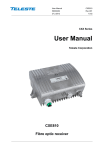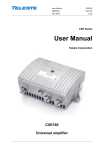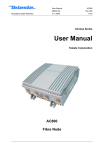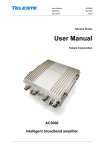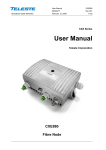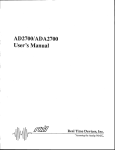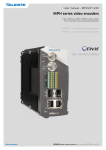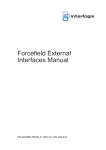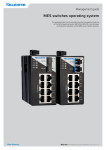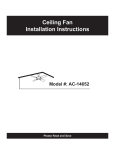Download User Manual
Transcript
Broadband Cable Networks User Manual 59300257 August 30, 2007 CXE800 Rev.003 1(8) CXX Series User Manual Teleste Corporation CXE800 Fibre Optic Receiver Broadband Cable Networks User Manual 59300257 August 30, 2007 CXE800 Rev.003 2(8) Introduction The CXE800 is a unidirectional, compact size fibre optic receiver. It is designed for areas where cost-efficiency and easy installations are prime concerns. The use of an integrated optical receiver eliminates time-consuming mounting of connectors and fibre splicing inside the housing. The optical receiver supports light wavelengths from 1290 nm to 1600 nm. Alignment of this product is easy. The Optical Level Control (OLC) as well as gain and slope adjustments use electrical controls that improve the reliability of this fibre optic receiver. Plug-in accessories are not needed in normal oneoutput operation. The distribution path, through the use of plug-in output modules, can be split easily in the field within matter of minutes, and a full range of taps/splitters are available. WEEE Notice This product complies with the relevant clauses of the European Directive 2002/96/EC on Waste Electrical and Electronic Equipment (WEEE). The unit must be recycled or discarded according to applicable local and national regulations. European Conformity This equipment conforms to all applicable regulations and directives of European Union which concern it and has gone through relevant conformity assessment procedures. User Manual 59300257 August 30, 2007 Broadband Cable Networks CXE800 Rev.003 3(8) Housing 8904047 1 2 3 4 Fig. 1. CXE800 Fibre Optic Receiver, 1) Optical fibre input port, 2) Ground, 3) RF output port2, 4) RF output port1 Installation The fibre optic receiver can be installed either into a street cabinet or to a sheltered outdoor environment. Note: Fibre adapter is not waterproof. The class of enclosure is IP43. The amplifier should be installed in a vertical position so that the external cable connectors are underneath. At least 100 mm of free space should be left above the amplifier to ensure sufficient cooling air circulation. The cover of the housing is closed by a single bolt. There are no hinges. Open cover is to be removed completely. When closing the cover use a PZD 2 screwdriver to tighten the bolt to a torque of 2.5...3.5 Nm. To ground the amplifier housing connect at least 4 mm2 grounding wire (Cu) from a proper earth to the grounding point. Cable connections Underneath the CXE800 fibre receiver there is one optical fibre input and one RF output with F-female connector. Optionally a second RF output is available. All coaxial outputs have a standard PG11 thread and they accept any KDC type adapter or connector. Figure 2 illustrates the centre conductor. 8905010 Fig. 2. Centre conductor length Broadband Cable Networks User Manual 59300257 August 30, 2007 CXE800 Rev.003 4(8) Powering The locally powered CXE800 fibre optic receiver is connected to the main voltage of 165…255 V AC via its own power cord. The power supply is double shielded and does not require separate grounding. However, the amplifier housing has to be grounded from the grounding point. The supply voltage fuse (T3.15 A / 250 V / TR5) is located on the upper right corner of the amplifier, beneath the shroud of the power supply unit. Fibre installation The CXE800 fibre optic receiver comes as standard with a bulkhead mounted SC/APC adapter. Fibre installation is a critical procedure and it should be done with carefulness. Incorrect handling of the fibre can result in damage and degraded performance. Warning: The SC/APC adapter is connected to the integrated fibre receiver through a short length of fibre on the rear side of the bulkhead. To avoid damage to the fibre, take care not to rotate the adapter when installing or removing the fibre connector. Cleaning fibre connectors • For correct optical operation ensure that all optical connectors are cleaned immediately before mating using a suitable optical connector cleaning kit. • If a cleaning kit is not available, wipe the end of the connector using pure isopropyl alcohol (99%) and a lint-free wipe. Dry it with filtered compressed air. Wait until dry to insert connector into the adapter. • When fibre optic connectors are unmated, the optical fibre end faces must be protected from contamination using suitable dust caps. Contamination of fibre end faces will reduce the performance of the optical fibre and could ultimately cause failure of the system. Contamination could also damage the fibre end faces when the connectors are mated. User Manual 59300257 August 30, 2007 Broadband Cable Networks CXE800 Rev.003 5(8) Connectors and plug-in slots 8906026 1 4 -12 O 2 E 5 -8 -15 -4 mid attenuator optical power 3 58800016_002 TP 10 V/mW OLC OFF output TP -20 dB 8 dB slope OLC ON output module flat OUTPUT 2 10 9 OUTPUT 1 8 7 Fig. 3. CXE800 plug-in placement 1) 2) 3) 4) 5) Integrated receiver Indicator for optical input power Optical power DC voltage test point Midstage attenuator Output test point, -20 dB directional coupler 6) 7) 8) 9) 10) Output module RF output port 1 RF output port 2 Slope selection OLC mode jumper OLC mode jumper (Fig. 3 pos. 10) Slope selection (Fig. 3 pos. 9) Off Sloped 8 dB On Flat Fig. 4. Jumper configurations. 6 User Manual 59300257 August 30, 2007 Broadband Cable Networks CXE800 Rev.003 6(8) Forward path / Optical receiver The optical receiver is integrated within the CXE800 and will accept both 1310 and 1550 nm wavelength optical inputs. The optical receiver provides both LED indicator and DC voltage test point for received optical power to quickly determine status of the unit. The output stage uses a GaAs MESFET output amplifier to improve RF performance over the entire 47 to 862 MHz passband. The distribution path, through the use of plug-in output modules, can be set up for a variety of output configurations. Refer to the ‘Table 1. Output modules’. Output module Attenuation at 862 MHz RF output port 1 RF output port 2 1.6 dB 1.1 dB 1.1 dB 4.0 dB 2.5 dB 12.5 dB 15.0 dB 20.6 dB 4.0 dB 8.3 dB AC6112 AC6116 AC6119 AC6124 AC6128 Table 1. Output modules. Optical input power Optical input power can be measured from the optical power DC voltage test point (Fig. 3 pos. 3). The test point DC voltage is directly proportional to optical input power in mW e.g. 10 V corresponds to 1.0 mW average optical power. Table below shows the correct measurements at the test point using a 1310 nm or 1550 nm transmitter. Operating wavelength 1310 nm Operating wavelength 1550 nm TP / V DC Input / dBm TP / V DC Input / dBm 10.00 7.94 6.31 5.01 3.98 3.16 2.51 2.00 0 -1 -2 -3 -4 -5 -6 -7 11.2 8.87 7.05 5.60 4.45 3.53 2.80 2.23 0 -1 -2 -3 -4 -5 -6 -7 Table 2. CXE800 optical receiver, expected levels. Do not connect any voltage to the test point or short circuit it to ground. Use a voltage meter with an input resistance higher than 100 kohms. Broadband Cable Networks User Manual 59300257 August 30, 2007 CXE800 Rev.003 7(8) The mainboard provides also a LED indicator (Fig. 3 pos. 2) which gives a visual indication of the optical input power. LED on CXE800 Condition Yellow Optical input power is below -7.0 dBm Green Red Optical input power is within the nominal range (-7.0…0 dBm) Optical input power exceeds 0 dBm Table 3. LED indicator on CXE800. Forward path adjustment The following are instructions to be used for a normal adjustment procedure. 1. Do not connect fibres or apply power before all the adjustments described below have been made. 2. Test the optical input power present on the fibre service cable using an optical power meter. The CXE800 integrated optical input power range is from -7 dBm to 0 dBm. 3. Optical Level Control (OLC) circuitry provides gain control that compensates for changes in input level caused by external variations. The available gain reserve is factory-set for optimum operation. If needed the output level can be adjusted with the midstage attenuator. You can however, set an internal jumper (Fig. 3 pos. 10) to disable the OLC. This enables you to operate the CXE800 optical receiver at full gain for applications that do not require gain stabilization. 4. Use the midstage attenuator to get wanted output level. The network plan should specify exact signal levels. Refer to the ‘Table 4 or 5. Midstage attenuator selection’. Output level (dBμV) without OLC 116 115 114 113 112 … Midstage attenuator (dB) 0 dB 1 dB 2 dB 3 dB 4 dB … Table 4. Midstage attenuator selection when input power is -3 dBm at 4% OMI. Broadband Cable Networks User Manual 59300257 August 30, 2007 Output level (dBμV) with OLC 110 109 108 107 106 … CXE800 Rev.003 8(8) Midstage attenuator (dB) 0 dB 1 dB 2 dB 3 dB 4 dB … Table 5. Midstage attenuator selection when input power is between 0…-7 dBm at 4% OMI. 5. Use the response mode jumper (Fig. 3 pos. 9) to select the midstage slope. Available options are “flat” or “8 dB sloped”. 6. Apply the power. 7. Connect the fibre connector to the bulkhead adapter.








